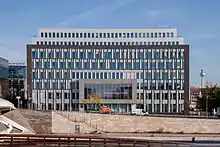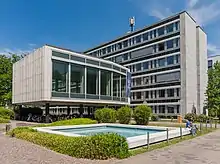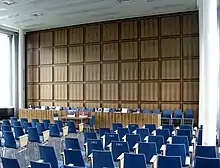Bundespressekonferenz
The Bundespressekonferenz (BPK) (German for Federal Press Conference) is a union of journalists, that report exclusively for German media. The main headquarters is in Berlin, while there is also a second office in Bonn. It is an association modelled after the image of journalists of the Weimar Republic, which invites representatives of the German cabinet, members of political parties, federations, and individuals of national political, economic, and social interest to press conferences. It is financed solely through membership fees. Membership of the Bundespressekonferenz is limited exclusively to German journalists that report from either Bonn or Berlin. It has 900 parliamentary correspondents (December 2020). The most important committee is the general assembly. It appoints the 8 members of the board, which take turns in leading the press conferences. [1]

Organization

The institution was founded in 1949 as a civil law association. It has been a registered association since May 19, 1953, the purpose of which is to hold press conferences and to provide its members with "opportunities to provide comprehensive information to the public", as stated in its statutes. At first, foreign correspondents also belonged to the BPK, until the Association of the Foreign Press in Germany (VAP) was founded in January 1951. Although it was originally founded in 1906, it was inactive from 1945 to 1951, when it was re-established in the BRD and GDR as separate associations. Alongside members of the BPK, only members of the VAP have the right to participate and ask questions. In October 2009, ninety-three members were still working in the former German capital Bonn, as important political tasks are still performed within the city in its capacity as a federal city. Since the year 2000, the association has had its own building in the centre of Berlin rented from the Allianz Group, which also houses offices for correspondents. The building of the Federal Press Conference was designed by the architects Johanne and Gernot Nalbach in 1998 and completed two years later.
Peculiarity
In contrast to the practice in many other states, the "hosts" of the federal press conferences are the journalists themselves and not the government, ministries, political parties, associations, world view communities or individual politicians. As a result, journalists who are known for their critical questions always have their say, while at comparable events in other countries, these journalists often ask arranged or no questions. For the same reason, some guests refrain from appearing before the Federal Press Conference. The Chancellors, for example, usually only come to the Federal Press Conference once a year and otherwise organize their own press conferences at the Chancellery. Joschka Fischer was also known for avoiding the Federal Press Conference in his time as Foreign Minister.
The government press conference takes place three times a week on Mondays, Wednesdays, and Fridays. For this purpose, the press secretaries of the Federal Government and the ministries are invited as a matter of routine. After their brief introductory statements, they answer questions from the journalists. The guests in the press conference may mark individual explanations as confidential and it is in line with the journalists' voluntary commitment to the press code to maintain this confidentiality. In practice, guests rarely use this option. Only members of BPK and the foreign correspondents affiliated to the VAP have the right to participate and ask questions in the events.
History


The earliest roots of today's Federal Press Conference are in the press conferences organized by the General Staff of the Imperial Army during the First World War, which held from 1915, the former stock market journalist and Major Georg Schweitzer. He had already been one of the founding members of the Imperial Press Ball. The "teaching of the people" corresponded to the then prevailing patriotic mood.
After the abolition of the monarchy, the journalists working in Berlin of the leading German daily newspapers took the organization of press conferences into their own hands and invited politicians and government spokespersons as guests, instead of the other way around. After the Second World War, the form of the press conferences of the Weimar Republic was reopened. In 1947 the state press conference in Hanover and in 1948 the Frankfurt press conference at the Economic Council were created at first. It broke up again with the founding of the Federal Republic at the end of 1949 and is regarded as a direct forerunner of the Bundespressekonferenz in Bonn. Many of their founding members moved from the Frankfurt press conference to Bonn, after the Federal Government and Parliament had constituted there in 1949.
On 15 September 1949, the day of the first Chancellor's election, a group of newspaper correspondents called by notice in Bonn's Federal Parliament "all journalists accredited to the Federal Parliament for the establishment of a federal press conference" on. Four days later, the inaugural meeting took place, but officially the BPK was constituted only on 11 October 1949 with the election of a managing committee. At the first Federal Press Conference in its own responsibility, which took place in the plenary hall of the Federal Council on 17 or 18 October 1949, Federal Chancellor Konrad Adenauer and Economics Minister Ludwig Erhard answered the questions of the member journalists. Later, the press conferences usually took place in the hall of the Defense Committee. Immediately after the founding of the BPK in 1949, certain members of the executive board were entrusted with one of the most urgent organizational tasks of the postwar period: the procurement of housing for the Bonn journalists. At that time, a quota of 10% for the local members in the occupation of social housing could be enforced, which were originally intended only for employees of the Bundestag. Therefore, a number of journalists also lived in the Reutersiedlung. After further subsidies (such as the assistance of survivors) were added, the Social Fund Federal Press Conference was launched.
After the construction of the Berlin Wall in 1961, there was a change to the statutes in the autumn to exclude all East German correspondents from the BPK. It remained in the more than 40-year history of the Bonn Republic, the only exclusion against accredited journalists. It existed for almost 10 years, until on 8 February 1971, the "Exclusion Paragraph" for East German journalists was removed from the statute and three years later, the required admission to the Foreign Press Association was made possible. From October 1967, the federal press conference with its hall was located in the so-called "Pressehaus" in the government District in Bonn. Their identifying mark was a meter-high, squarish rosewood wall. After the fall of the Berlin Wall, BPK supported the founding of the "Press Conference Capital Berlin" in the spring of 1990, which became the "Berlin branch of the BPK" after German unity. With the relocation of government and parliament in 1999, BPK also relocated its headquarters to Berlin. The room in which the Federal Press Conference takes place, as well as the offices of the club employees, are rented by Allianz (alliance), which owns the building. Even after moving to Berlin, however, the Federal Press Conference is still represented with a branch office in the Bonn federal district. In the final speech of the then deputy spokeswoman Charima Reinhardt on 4 August 1999 in the government District in Bonn, the number of press conferences held there was stated as "between 9,000 and 10,000".[2][3][4][5]

Chairman
- 1950–1951: Irnfried Freiherr von Wechmar
- 1951–1952: Fritz Brühl
- 1952: Karl Lohmann
- 1953: Franz Rodens
- 1953–1954: Wilhelm K. Papenhoff
- 1954–1956: Ferdinand Himpele
- 1956–1961: Harald O. Herrmann
- 1961–1962: Wolf Dietrich
- 1962–1963: Reinhard Appel
- 1963–1967: Hans Viefhaus
- 1968–1970: Hans Reiser
- 1971: Ernst Ney
- 1972–1973: Jürgen Lorenz
- 1974–1975: Hans Werner Kettenbach
- 1976–1980: Ernst Ney
- 1981–1989: Rudolf Strauch
- 1990–1995: Sten Martenson
- 1995–1999: Heinz Schweden
- 1999–2003: Tissy Bruns
- 2003–2011: Werner Gößling
- since 2011: Gregor Mayntz
Socialfunds Bundespressekonferenz
The Sozialfonds Bundespressekonferenz is an independent self-help institution of members of the Federal Press Conference in the form of a registered non-profit association based in Berlin. The members come from the circle of the Federal Press Conference. The annual meeting of the members advises social measures and oversees the finances of the association. From among the members of a three-member board is elected, which determines its chairman. The purpose of the Fund is to assist journalists or their survivors in distress through ongoing financial contributions or one-time subsidies. The financial aid of the Social Fund comes primarily from the proceeds of the tombola of the annual Bundespresseball in Berlin. In addition, the association receives irregular donations from sponsors. Recipients of these services are preferably former or current members of the Federal Press Conference. The Board decides on grants after examining the individual cases.
Award of the Bundespressekonferenz
Since 2014, the so-called Prize of the Federal Press Conference – a keyboard engraved in crystal – has been awarded annually as part of the Federal Press Ball. The price honors extraordinary efforts for the freedom of the press. Previous winners are the Reuters correspondent Gernot Heller (2014), Der Spiegel reporter Christoph Reuter (2015), the long-time director of the ARD (broadcaster) studio in Brussels Rolf-Dieter Krause (2016), the Deutsche Presse-Agentur correspondent Kristina Dunz (2017) and the Phoenix journalists Gerd-Joachim von Fallois and Erhard Scherfer.
References
- https://www.bundespressekonferenz.de/verein/der-verein
- BONN, GA. "Bundespressekonferenz feiert 60. Geburtstag". GA BONN.
- Fiedler, Anke. "Mit dem Rücken zur Mauer". bpb.de.
- "Bürobauten Tulpenfeld – Weg der Demokratie". www.wegderdemokratie.de.
- ZEIT (Archiv), D. I. E. (10 June 1966). "Fair zu Sprecher Hase: Die Bundes-Pressekonferenz e. V. – Bilder aus der deutschen Presse (IX): Eine halbe Stunde Bonner Routine" – via Die Zeit.
Further reading
- Gunnar Krüger: Wir sind doch kein exklusiver Club! Die Bundespressekonferenz in der Ära Adenauer. LIT-Verlag, Münster 2005, ISBN 3-8258-8342-6
- Bernd F. Köhler: Die Bundes-Pressekonferenz. Annäherung an eine bekannte Unbekannte. Phil. Diss., Mannheim 1988, Selbstverlag (ausführlicher Literaturüberblick zum Thema)
- Manfred Koch und Waltraud Hausmann: ‚Auf ewig‘. Inhaltsanalytische Untersuchung über den Kommunikationsfluß nach der Bundespressekonferenz vom 9. Mai 1969. In: Publizistik, 16. Jahrgang 1971, Heft 4, Seuteb 369–378
- Ernst Ney: Die Bundespressekonferenz – Resonanzboden Bonner Politik. In: Heinz-Dietrich Fischer (Hrsg.): Regierungssprecher – Zwischen Information und Geheimhaltung. Verlag Wissenschaft und Politik, Köln 1981, ISBN 3-8046-8581-1, Seiten 89–106
- Eckart Klaus Roloff: Bundespressekonferenz. Kommentierte Materialien zur beruflichen Organisation von Bonner Korrespondenten. In: Publizistik, 22. Jahrgang 1977, Heft 2, Seiten 248–256 (mit Literaturliste)
- Eckart Klaus Roloff: Die Bundespressekonferenz – ein Klüngel? In: Der Journalist, 25. Jahrgang 1975, Heft 3, Seiten 25–27
- Eckart Klaus Roloff, Walter Tausch und weitere Mitarbeiter (nach einem Konzept von Günter Kieslich): Input-Output-Analyse der Informationsleistung staatspolitischer Organe in der Bundesrepublik Deutschland. Leitstudie an Hand der Befragung von Mitgliedern der Bundespressekonferenz. Maschinell vervielfältigt Salzburg, Institut für Publizistik und Kommunikationstheorie 1972
- Holger Schmale: Hier haben Journalisten das Sagen. Vor 65 Jahren wurde die Bundespressekonferenz gegründet, diese Institution gibt es nur in Deutschland. In: Frankfurter Rundschau vom 11./12. Oktober 2014, Seiten 37
External links
| Wikimedia Commons has media related to Bundespressekonferenz. |
- Bundespressekonferenz Official Website